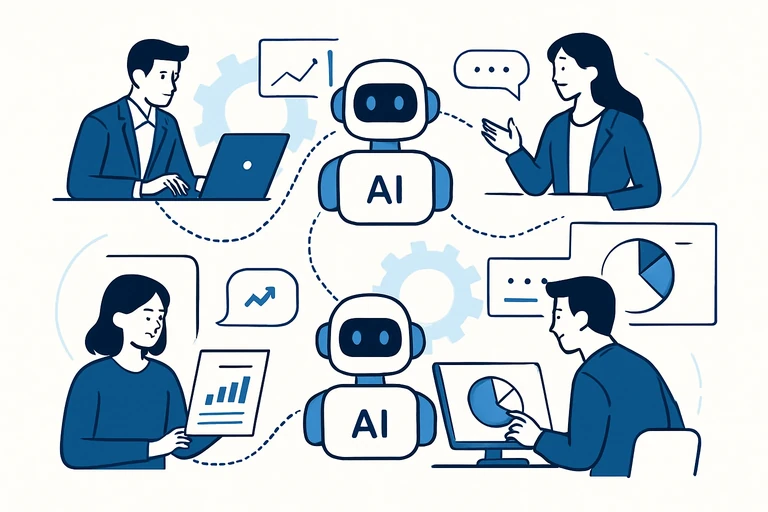The Rise of Autonomous Agents in 2025 explores practical patterns, platforms, and governance conside...

Reducing Development Costs with Agile Methodologies
A practical, evidence-based guide to reducing software development costs through agile, Lean, and DevOps practices. Learn how to short-circuit waste, accelerate learning, and deliver value faster without compromising quality.
Introduction
In today’s fast-moving software landscape, you don’t just want to deliver value—you want to do it efficiently, with high quality and predictable costs. Agile methodologies offer a proven pathway to reduce development waste, shorten feedback loops, and deliver working software faster. Leading global consultancies report that agile transformations can materially improve financial performance and time-to-market, often yielding double- or triple-digit improvements in velocity and meaningful cost savings when implemented with discipline. For example, McKinsey has documented cases where enterprise agility can drive 20–30% improvements in financial performance and substantial cost savings as organizations reallocate capacity toward higher-value work. At the same time, strategic lean practices—eliminating waste, accelerating learning, and delivering in smaller, faster cycles—consistently correlate with shorter development times and higher quality. These insights frame a practical, implementable approach to lowering your development costs without sacrificing system reliability or user value. Sources: McKinsey on enterprise agility and cost outcomes; PMI on cost of change and feedback loops.
Why Agile Methods Help Lower Development Costs
Cost reduction in software development isn’t just about shaving a few dollars off the bottom line. It’s about reducing the variables that drive cost—rework, scope creep, late fixes, and long feedback cycles. Agile practices address these drivers directly in several ways:
- Faster feedback and reduced rework: Short iterations and frequent stakeholder feedback allow teams to course-correct early, lowering costly rework and defect remediation later in the project. This aligns with evidence that shorter feedback loops reduce the average cost of changes and the amount of rework required over the life of a project. PMI: Cost of Change; shorter feedback cycles reduce the cost of making changes.
- Incremental delivery and early value realization: By delivering working software in small increments, you validate requirements early and avoid investing heavily in features that may not deliver value. McKinsey’s enterprise agility research highlights how agile transformations can yield financial and value-based improvements, including cost savings in the 20–30% range in some cases. McKinsey: Enterprise Agility and Financial Impact.
- Reduced waste with Lean principles: Lean software development emphasizes eliminating non-value-adding work, building quality in, and delivering fast. This focus on value streams helps teams shorten cycle times and reduce waste—key levers for lower total cost of ownership. 7 principles of Lean software development and Lean project management guidance.
Core Practices That Cut Costs Without Compromising Quality
These practices are not merely theoretical; they are concrete, repeatable actions that teams can adopt to reduce costs while delivering reliable software.
1) Short, predictable iterations and disciplined scope
Adopt 1–2 week sprints (or a cadence that fits your domain) with a clearly defined, small scope for each sprint. This keeps risk manageable, reduces the likelihood of expensive, late-stage rework, and makes it easier to forecast delivery—an essential cost-containment discipline. Agile transformations in large organizations show measurable efficiency gains when teams operate with small, stable cross-functional units and clear product narratives. McKinsey: Agile teams and productivity; deployment improvements in agile contexts.
2) Build quality in through automated testing and CI/CD
Shift left on quality by automating tests and integrating them into a continuous integration/continuous delivery (CI/CD) pipeline. Automated testing reduces the time spent on manual regression testing and catches defects earlier, substantially lowering defect-related costs. In practice, teams that embrace CI/CD and automated testing deploy more frequently with fewer post-release defects. PMI cost-of-change framework; McKinsey on rapid deployment and IT capabilities.
3) Lean thinking: map value streams and eliminate waste
Value-stream mapping helps you visualize the entire development flow, identify bottlenecks, and remove wasteful activities (e.g., lengthy handoffs, duplicate work, unnecessary approvals). The Lean software development principles emphasize eliminating waste and delivering fast, which translates to lower cycle times and reduced costs associated with delays and rework. 7 Lean principles and Lean PM guidance.
4) Focus on MVPs and validated learning
Start with a Minimal Viable Product (MVP) to validate core value quickly, then iterate based on real user feedback. This approach lowers upfront investment, reduces risk, and ensures funds are directed toward features that matter most to users. While MVP is a widely used concept in software, the cost discipline it enables is reinforced by agile and lean research, which emphasize faster learning cycles and tighter scope control. General industry practice; Lean/Agile alignment in enterprise contexts.
5) Cross-functional teams and empowered product owners
Cross-functional teams—comprising developers, testers, and product stakeholders—reduce dependencies and accelerate decision-making. Empowered product owners maintain clarity on business value, helping to prevent scope drift and unnecessary features. Enterprise agile studies highlight how reorganizing teams and reducing handoffs can yield cost efficiencies. McKinsey enterprise agility, PMI cost-of-change commentary.
6) Continuous improvement and retrospectives
Regular retrospectives identify action items to cut waste and improve practices in the next cycle. Continuous improvement is a core Agile principle and is shown to contribute to higher throughput and more predictable delivery, which reduces the risk of budget overruns. Atlassian Continuous Improvement guide; Agile Alliance debt analysis model.
Frameworks and How They Translate to Cost Savings
Different agile frameworks offer different strengths for cost optimization. The choice should be driven by your product, team culture, and risk profile.
Scrum for predictable value delivery
Scrum emphasizes time-boxed iterations, cross-functional teams, and a transparent backlog. When properly implemented, Scrum helps teams focus on the highest-value work first, reducing the risk of late feature creep and expensive rework. It also naturally supports shorter feedback loops through sprint reviews and stakeholder involvement. Scrum guidance and agile best practices.
Kanban for flow and waste reduction
Kanban visualizes work in progress (WIP) and helps teams limit and optimize flow. By pulling work through a constrained system, teams can reduce context switching, shorten cycle times, and prevent overloading—common drivers of waste and cost overruns. Kanban is often used to complement Scrum, especially in maintenance or support contexts where work arrives unpredictably. Lean Kanban guidance and visual management literature.
Lean and Scaled Agile approaches
Lean software development principles align well with agile at scale. They focus on eliminating waste, building quality in, and delivering quickly, which dovetails with enterprise objectives to reduce total cost of ownership while accelerating time-to-value. Lean software development principles; McKinsey on scaled agile at the enterprise level.
A Practical 12-Week Plan to Reduce Costs
Use this concrete, repeatable plan to start cutting costs while preserving value and quality. Adapt timelines to your organization’s size and maturity.
- Week 1–2: Map the value stream — Document the end-to-end development flow, from idea to production, and identify wasteful steps and bottlenecks. Create a baseline for lead time, cycle time, and WIP. Why it matters: you can target the largest sources of wasted effort first.
- Week 2–3: Define an MVP and a product roadmap — Prioritize features by business value and impact, and lock in a clear MVP scope to minimize early overinvestment. Tip: keep a tight product backlog with explicit acceptance criteria.
- Week 3–5: Establish a CI/CD pipeline — Automate builds, tests, and deployments so you can release frequently with confidence. Impact: you’ll reduce manual QA costs and accelerate feedback.
- Week 4–6: Implement automated testing and quality gates — Invest in unit, integration, and end-to-end tests that run in CI. Benefit: shorter defect cycles and lower post-release remediation costs.
- Week 5–7: Pilot a Kanban-based flow in a pilot team — Visualize work, limit WIP, and measure cycle times. Use this pilot to gather data for scaling. Rationale: better flow reduces idle time and rework.
- Week 6–8: Retrospectives and action planning — Identify top-waste actions and assign owners. Track improvements in a simple dashboard. Why: continuous improvement compounds cost savings over time.
- Week 7–9: Reorganize around cross-functional teams — Minimize handoffs by consolidating skills in squads that own features from idea to production. Benefit: faster decisions, less rework.
- Week 8–10: Optimize cloud and infrastructure spend — Right-size environments, implement auto-scaling, and adopt pay-as-you-go models where possible. Impact: reduces waste in underused resources.
- Week 9–11: Measure and iterate on metrics — Track lead time, cycle time, throughput, and defect rate. Use trends to adjust priorities. Key metrics: these show you where costs are coming from and whether changes reduce them.
- Week 10–12: Scale what works — Roll out successful practices to additional teams, formalize the governance model, and set up a stop-start-finishing approach to avoid overinvestment. Outcome: a broader, sustainable cost reduction program.
- Throughout: maintain an MVP mindset and continuous learning loop — Keep learning, keep trimming non-value work, and keep delivering validated value.
Metrics and Evidence: How to Tell If You’re Saving Money
Choose metrics that reflect both efficiency and value:
- Lead time and cycle time: Shorter times indicate faster decision-making and reduced waste. Supports faster value realization and cost control.
- Deployment frequency and change lead time: Higher frequency with shorter lead times suggests an effective CI/CD process and reduced cost of changes. McKinsey IT deployment and agile productivity studies.
- Defect rate and post-release failures: Fewer defects mean less remediation cost and higher customer satisfaction. PMI cost-of-change frameworks and quality emphasis in agile practice.
- WIP and throughput: Lower WIP and steady throughput indicate better flow and fewer bottlenecks. Lean project management and Kanban guidance.
- Cost-to-serve and ROI of features: Compare the value delivered by features against their cost to implement. Enterprise agility research on value realization.
Practical Pitfalls to Avoid—and How to Beat Them
Cost reduction initiatives often fail when they focus on process for process’s sake or when leadership misreads the data. Here are common pitfalls and how to avoid them:
- Over-optimization at the expense of value: Don’t optimize for speed alone. Ensure each change delivers measurable value to users. Align with the North Star and customer-centric metrics. McKinsey and enterprise agility guidance.
- Under-investment in automation: Skimping on automated tests or CI/CD builds leads to fragile releases and higher long-term costs. Invest early in a robust automation foundation. PMI cost-of-change and quality emphasis.
- Inadequate governance for scaled Agile: Scale success with a clear operating model, not just local team wins. McKinsey suggests a centralized, value-focused approach for large transformations. McKinsey on scalable agile programs.
- Ignoring technical debt: Regularly address debt to avoid a buildup that negates early gains. Debt analysis models emphasize ongoing debt reduction as a cost-management discipline. Agile Alliance debt analysis model.
Conclusion
Reducing development costs with agile methodologies isn’t about cutting corners. It’s about cutting waste, accelerating learning, and delivering validated value faster and more reliably. By combining short iterations, automated testing and deployment, Lean value-stream thinking, and disciplined scope management, teams can realize meaningful cost savings while improving quality and time-to-market. The evidence from global consulting and industry organizations supports this approach: agile transformations and lean practices correlate with substantial improvements in productivity, reduced cycle times, and measurable cost reductions when implemented with a clear focus on value and customer outcomes. If you’re ready to explore how to tailor these practices to your product and organization, Multek can partner with you to design an agile, cost-conscious delivery model that fits your budget and your business goals.


